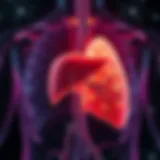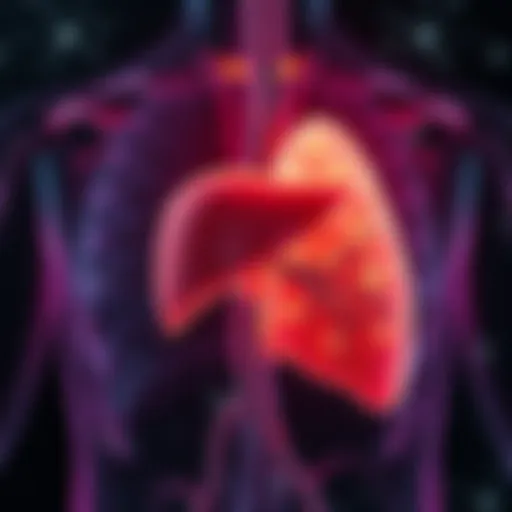Understanding Oral Lichen Planus: An In-Depth Overview


Intro
Oral lichen planus is a complex, chronic inflammatory condition that significantly affects the mucous membranes within the oral cavity. This disorder is characterized by the appearance of white patches, painful sores, and even ulcerations that can hinder everyday activities such as eating and speaking. As a multifaceted issue, it presents a unique challenge to healthcare providers and patients alike, necessitating collaborative understanding and management strategies.
Overview of Research Topic
Brief Background and Context
The condition is part of the wider spectrum of lichen planus, which can also affect the skin and other mucosal areas. It was first identified in the 1970s and has since been the subject of extensive study, although its exact etiology remains elusive. Potential triggers include medications, stress, and even viral infections, but the precise mechanism through which these factors contribute to the disorder is not fully understood.
Importance in Current Scientific Landscape
Exploring oral lichen planus is essential not only for improving individual patient outcomes but also for enhancing the broader understanding of mucosal diseases. Given the potential implications for oral health and overall well-being, researchers and healthcare professionals must prioritize this condition in their inquiry.
"Oral lichen planus is more than just an oral health issue; it is a systemic condition that reflects broader health challenges."
Methodology
Research Design and Approach
The research surrounding oral lichen planus utilizes various methodological approaches. Observational studies often form the backbone of clinical research in this area, allowing for identification of symptoms, prevalence, and potential triggers.
Data Collection Techniques
Data collection involves both qualitative and quantitative methods. Surveys can be conducted to gather patient experiences, while clinical examinations help gather objective data about presentation and severity. Patients often share their experiences in forums like Reddit and Facebook, highlighting the personal impact of the condition.
Understanding oral lichen planus requires a multi-dimensional approach that addresses the medical, psychological, and social aspects of the disease. Continued exploration in this field promises to reveal more about the nature of this condition, its treatment, and its management.
Prolusion to Oral Lichen Planus
Oral lichen planus represents a significant subject of study within the realm of mucosal conditions. Understanding this chronic inflammatory disorder not only provides insights into its etiology and clinical presentation but also informs effective management strategies for both healthcare professionals and patients. Oral lichen planus is not merely an isolated condition; it often intertwines with other systemic diseases and carries implications for the oral health of affected individuals.
Definition and Background
Oral lichen planus is defined as a chronic inflammatory disease primarily affecting the oral mucosa. Characterized by white, lacy patches, redness, and swelling, it can vary widely in presentation. The lesions may cause discomfort or be asymptomatic, leading to challenges in diagnosis. The exact cause of oral lichen planus remains unclear, but immune-mediated mechanisms seem to play a central role. This condition typically occurs in middle-aged adults, with a notable prevalence among women. It is essential to recognize its clinical forms, which can manifest as reticular, erosive, or plaque-like lesions.
Relevance in Clinical Practice
The relevance of understanding oral lichen planus in clinical practice cannot be overstated. The condition can have profound effects on a patient's quality of life, leading to issues with eating, speaking, and overall well-being. Furthermore, it is crucial for clinicians to differentiate oral lichen planus from other similar lesions that may have different treatment and prognostic implications. A proper understanding allows for early diagnosis and intervention, reducing the risk of complications. Moreover, the management of oral lichen planus often requires a multidisciplinary approach, engaging dermatologists, dentists, and sometimes immunologists to deliver comprehensive care.
Etiology of Oral Lichen Planus
The etiology of oral lichen planus is a critical aspect of understanding this complex condition. The term etiology refers to the cause or causes of a disease. Knowing the factors that contribute to the development of oral lichen planus can help practitioners devise more effective treatment strategies and inform patients about what may have triggered their symptoms. This section looks at the immune response mechanisms, genetic predispositions, and environmental factors that can play significant roles in the onset and progression of oral lichen planus.
Immune Response Mechanisms
Oral lichen planus is primarily considered an autoimmune disorder. The immune system mistakenly attacks the cells in the oral mucosa, leading to inflammation and damage. This abnormal immune response is often linked to various triggers, including medications, infections, and stress. Research indicates that the presence of certain autoantibodies may contribute to tissue injury. More specifically, the destruction of basal epithelial cells makes the oral mucosa more vulnerable to further insult. Understanding these mechanisms is crucial for developing targeted therapies aimed at modulating the immune response and alleviating symptoms.
Genetic Predispositions
Genetics may also play a role in the occurrence of oral lichen planus. While the exact genetic markers remain unclear, studies suggest that individuals with a family history of autoimmune disorders may have an increased risk of developing this condition. Some genes, particularly those involved in immune regulation, could predispose individuals to abnormal immune responses. Identifying these genetic factors could lead to better diagnostic methods and personalized treatment approaches, enabling health professionals to assess if a patient has a higher risk if they have a familial linkage.
Environmental Factors
Environmental influences may significantly impact the pathogenesis of oral lichen planus. These can include mechanical trauma, the use of certain dental materials, and exposure to specific substances. Factors like tobacco utilization and viral infections, particularly the hepatitis C virus, have been noted as possible triggers. Mapping out these environmental triggers is essential for both prevention strategies and patient education. Patients should be advised to minimize exposure to potential irritants, as their environments might exacerbate their conditions.


Classification of Oral Lichen Planus
The classification of oral lichen planus is vital for understanding the various manifestations and implications of this condition. It allows healthcare providers to determine the most appropriate management strategies, facilitates communication among professionals, and enhances patient education. By categorizing the disease into distinct types and variants, clinicians can better assess the severity and potential complications associated with each classification. This section elucidates the types of oral lichen planus and highlights their clinical significance and presentation.
Types and Variants
Reticular
Reticular oral lichen planus is characterized by a network of white lines known as Wickham's striae. These lines may appear on the buccal mucosa, and in some cases, on the tongue or other mucosal surfaces. The reticular form usually does not cause pain or discomfort, making it a common presentation in patients who may not seek immediate treatment. Its key characteristic is its appearance, which is relatively easy to identify during clinical examination. This form is often viewed as benign, leading to less aggressive treatment approaches.
The presence of Wickham's striae is a unique feature of the reticular variant. This pattern helps differentiate it from other forms of oral lichen planus. A notable advantage of recognizing reticular lichen planus lies in its generally favorable prognosis, as it is less likely to progress to more severe forms. However, patient awareness is necessary, since the condition may still require monitoring.
Erosive
Erosive oral lichen planus presents as ulcerated lesions that may be painful and can significantly affect a patient’s quality of life. This variant can lead to considerable discomfort during eating, speaking, and daily activities. One of its key characteristics is the presence of painful erosions that often appear on the mucosal surfaces, sometimes leading to scarring.
The erosive form is a serious concern since the pain and inflammation can lead patients to experience difficulties in basic functions. A major disadvantage of this variant is the recurrent episodes of pain it can induce, which may necessitate stronger medical interventions, such as systemic corticosteroids. Recognizing erosive lichen planus early is crucial for effective management.
Plaque-like
Plaque-like oral lichen planus is identifiable by its thick, white lesions that resemble leukoplakia. These plaques can occur on various oral surfaces and may be confused with other conditions. The key characteristic here is the plaque's consistency and affected sites, which require careful examination to differentiate from other oral pathologies. This distinction is important for an accurate diagnosis and subsequent treatment plan.
The unique feature of plaque-like lichen planus is its possible resemblance to malignancies, leading to concern for oral cancer. This variant emphasizes the need for thorough differential diagnoses. An advantage is that, once diagnosed, it can usually be managed effectively with topical therapies. However, patients must be longitudinally assessed due to potential variations in the lesions.
Actinic
Actinic oral lichen planus is notably less common than other forms but carries importance due to its link to sun exposure. This variant typically arises on mucosal surfaces exposed to ultraviolet light and may appear as white, reticular lesions. The unique feature of actinic lichen planus lies in its correlation with solar damage, which may be particularly relevant for patients with extensive sun exposure.
This form serves to enrich our understanding of the environmental influences on oral lichen planus. An advantage of recognizing actinic lichen planus is the ability to educate patients about preventive measures against UV exposure. However, the less frequent nature of this variant can lead to challenges in diagnosing and differentiating from other conditions related to sun damage.
Symptoms and Clinical Presentation
In this section, we will examine the symptoms and clinical presentations commonly associated with oral lichen planus. Understanding these signs is essential for early detection and effective management of the condition.
Diagnosis of Oral Lichen Planus
Diagnosis of oral lichen planus is crucial for effective management of this complex condition. A thorough diagnosis allows for differentiation from similar disorders and ensures appropriate treatment strategies are applied. Recognizing the signs and symptoms early can greatly improve patient outcomes and quality of life. Given its chronic nature, timely diagnosis can help prevent further complications and assist in monitoring disease progression.
Clinical Examination Techniques
Clinical examination techniques are the first step in diagnosing oral lichen planus. Practitioners typically begin with a detailed medical history. This history takes into account not only the patient's symptoms but also any relevant risk factors. The primary goal of clinical examination is to observe the characteristic lesions that define the condition.
Often, the examination includes visual inspection of the oral cavity, focusing on areas like the buccal mucosa, gums, and tongue. Key signs include a lace-like white pattern known as Wickham's striae. Other features may include atrophic, erosive, or ulcerative lesions. These visual cues are significant as they help narrow down the diagnosis.
In addition to visual examination, palpation may be performed to assess the texture and tenderness of lesions. All findings are documented meticulously for further evaluation and possible referral for histopathological assessment.
Histopathological Findings
Histopathological analysis provides a definitive diagnosis of oral lichen planus. This process starts when a biopsy is performed, usually on lesions that exhibit significant changes. The tissue sample is then examined under a microscope. Findings commonly include a band-like infiltrate of lymphocytes at the basal layer of the epithelium.
Moreover, there may be liquefactive degeneration of the basal cell layer, which supports the diagnosis. Identifying these histopathological features is crucial because they help rule out conditions like pemphigoid or other autoimmune diseases. Thus, histopathology not only aids in confirming lichen planus but also contributes to the overall understanding of the disease's mechanism.
Differential Diagnosis
Differential diagnosis is an essential process in confirming oral lichen planus. Various conditions may present similarly, making this step critical. Key considerations include mucous membrane pemphigoid, lupus erythematosus, and oral candidiasis. Each of these conditions has distinct characteristics and may require different treatment approaches.
To narrow down the possibilities, medical professionals typically consider patients' age, systemic symptoms, and lesion characteristics. Careful comparison of clinical and histopathological features often helps differentiate between these disorders.


There is significant importance in confirming the diagnosis to optimize treatment plans and improve patient quality of life.
Management Strategies
Management strategies are crucial for addressing oral lichen planus effectively. They encompass a range of treatments and approaches aimed at alleviating symptoms, improving the quality of life, and preventing complications. Understanding these strategies enables both healthcare professionals and patients to make informed choices about care.
A multi-faceted approach often provides the best outcomes. By integrating medical and alternative therapies alongside patient education, individuals affected by oral lichen planus can find relief from symptoms such as pain and discomfort. The following sections explore specific medical treatments, alternative therapies, and the significance of patient support in managing this condition.
Medical Treatments
Topical Corticosteroids
Topical corticosteroids are regularly prescribed in managing oral lichen planus due to their effectiveness in reducing inflammation. One key characteristic is their ability to directly target affected areas in the mouth, minimizing systemic side effects that might occur with oral medications. As a first-line treatment, topical corticosteroids help manage pain and promote healing.
They work by suppressing immune responses that contribute to inflammation, providing significant relief for many patients. However, users should be aware of potential drawbacks such as the risk of local irritation or mucosal atrophy with prolonged use. Ultimately, these medications are popular choices due to their focused action and relative safety profile.
Systemic Corticosteroids
Systemic corticosteroids are another avenue for treatment, particularly in more severe cases of oral lichen planus. Their ability to manage widespread symptoms is a significant advantage. These medications are beneficial for quick control of symptoms but are generally reserved for cases where topical treatments are insufficient.
The key feature of systemic corticosteroids is their comprehensive effect on the immune system, which can lead to rapid symptom amelioration. However, long-term use poses risks such as weight gain, hypertension, and increased susceptibility to infections. Thus, careful monitoring by a healthcare provider is essential when considering this option.
Immunosuppressants
Immunosuppressants are often explored for patients who do not respond to corticosteroid therapy. These medications work by dampening the overall immune response, addressing the underlying issue contributing to oral lichen planus. Some common immunosuppressants prescribed include azathioprine and mycophenolate mofetil.
Their unique feature is the ability to lower the chance of an exacerbated immune response while also offering a more sustained control over the condition. The downside, however, includes potential side effects such as increased risk of infections and potential toxicity. Thus, their use should be judicious and closely managed by healthcare professionals.
Alternative Therapies
Phototherapy
Phototherapy, which involves the use of light to treat skin and mucosal conditions, has emerged as an alternative in managing oral lichen planus. It works by modulating the immune system and reducing inflammation. A key characteristic of phototherapy is its non-invasive nature and focus on localized treatment. Many patients find this method to be beneficial as it does not carry the systemic effects typically associated with oral medications.
However, the accessibility of phototherapy can be limited, and some patients may not respond adequately. Its efficacy relies on careful application and tailored treatments.
Biologics
Biologics represents a frontier in managing chronic inflammatory diseases, including oral lichen planus. They function by targeting specific pathways in the immune system, and some biologics are currently being studied for their effectiveness in this condition.
The unique feature of biologics lies in their ability to provide a targeted approach, minimizing general immune suppression while effectively controlling disease manifestations. However, the costs associated and the need for ongoing treatment can be barriers to their widespread adoption.
Patient Education and Support
Fostering patient education and support is vital for individuals dealing with oral lichen planus. Knowledge about the condition empowers patients to manage their symptoms and communicate effectively with healthcare providers. Education can include information about dietary modifications, oral hygiene practices, and potential side effects of medications.
Support groups and resources can also play a significant role in providing emotional support and shared experiences, helping individuals navigate the complexities of this chronic condition. By understanding their condition and treatment options, patients are better prepared to adhere to management strategies and maintain their quality of life.
Overall, comprehensive management did strategies for oral lichen planus combines medical treatments, alternative therapies, and patient engagement, leading to improved patient outcomes and quality of life.
Prognosis and Complications
The prognosis and complications associated with oral lichen planus are critical components in understanding this condition. Individual patient outcomes can vary widely based on multiple factors, including the severity of the disease, treatment response, and patient adherence to management strategies. For clinicians, recognizing these elements is important for creating tailored treatment plans that can enhance patient quality of life.
Long-term Outcomes


Long-term outcomes for individuals with oral lichen planus generally depend on the patient's specific presentation. Most patients experience periods of remission and exacerbation due to the chronic nature of the disease. Factors influencing the progression include:
- Severity of Symptoms: Patients with more intense lesions may have a higher risk of complications.
- Adherence to Treatment: Consistent use of recommended treatments can lead to better outcomes.
- Psychological Factors: Stress and anxiety can exacerbate symptoms and affect healing.
Many patients achieve a relatively stable condition with appropriate management. Regular follow-ups are vital for monitoring progression and adjusting treatments as necessary. Long-term studies suggest that while most patients do not experience significant complications, a subset may have prolonged discomfort that affects daily life.
Risk of Malignant Transformation
One notable concern in patients with oral lichen planus is the potential risk of malignant transformation. Studies indicate that there is a small but measurable risk for lesions, particularly the erosive and plaque-like variants, evolving into squamous cell carcinoma. Key considerations include:
- Type of Lichen Planus: Erosive forms carry a higher risk compared to reticular types.
- Duration of Condition: Long-standing lesions might have an increased risk of neoplastic changes.
- Biopsies and Surveillance: Regular examinations and biopsies help in early detection of any atypical changes in the mucosa.
Regular oral examinations are essential for early identification of any complications.
In summary, while most patients with oral lichen planus can manage their symptoms effectively, awareness of long-term outcomes and the risks of malignant transformation is essential. Comprehensive care, involving regular monitoring and adjustments to treatment, will support better health trajectories for patients.
Recent Research and Developments
Research into oral lichen planus is evolving, with advancements in diagnostics and treatment proving essential for managing this complex condition. Understanding these developments enhances clinical practice and patient outcomes. New methods offer insights into the disease’s mechanisms, while treatment innovations promise greater efficacy, targeting the condition's underlying causes rather than just alleviating symptoms. This section addresses recent progress in both diagnostic approaches and treatment strategies, which are vital for practitioners and patients alike.
New Diagnostic Approaches
Recent advances in diagnostic techniques for oral lichen planus include the use of molecular biology and imaging technologies. These innovations allow for more accurate and earlier detection of the condition. For instance, biomarkers are being identified that can differentiate oral lichen planus from other similar oral lesions. This differentiation is crucial because early and correct identification can lead to more effective management strategies.
Moreover, advancements in digital imaging can help clinicians visualize the lesions more clearly, leading to better assessments and monitoring.
Key components of these new diagnostic approaches include:
- Molecular markers: Can indicate the type and severity of lichen planus.
- Digital imaging: Facilitates better visualization of lesions, improving diagnostic accuracy.
- Biopsy techniques: Improved methods can yield more reliable histopathological results with less discomfort for the patient.
Improvements in these areas can reduce the need for invasive procedures and provide a more patient-friendly approach, making consultations less stressful for individuals.
Innovations in Treatment Protocols
The treatment of oral lichen planus has also seen significant innovations recently. Modern therapeutic strategies focus on individualized patient care, recognizing that responses to treatment can vary widely.
Current trends include:
- Targeted therapies: New drugs designed to specifically inhibit pathways involved in the inflammatory process associated with oral lichen planus. This reduces side effects compared to traditional therapies.
- Biologics: These are increasingly being explored for managing chronic conditions, offering targeted actions against immune responses at a molecular level, thus minimizing broader systemic impacts.
- Combined therapies: Utilizing a mix of topical and systemic treatments can enhance efficacy while lowering dosage and potential side effects.
Significant clinical trials are underway to evaluate these strategies, providing evidence on the long-term benefits and risks of novel treatments. Practitioners must stay updated on these advancements to make informed decisions about patient care.
"Innovations in treatment methods are not just about effectiveness; they also aim to improve patients’ quality of life during the treatment process."
The integration of these advancements is crucial. By understanding recent research and developments, professionals can offer patients valuable insights, improving their management of oral lichen planus. This crucial knowledge base fosters a deeper understanding of future treatment opportunities and diagnostic tools.
Closure
The conclusion section serves a significant role in encapsulating the key themes presented throughout the article on oral lichen planus. It provides a cohesive summary that underscores the relevance of this condition in both clinical practice and personal health.
Summary of Findings
In summary, oral lichen planus is more than just a superficial oral disorder. It reflects underlying immune responses and interactions that require careful evaluation. The article covered the following essential points:
- Definition and Background: Offered a foundational understanding of what oral lichen planus entails.
- Etiology: Discussed the immune responses, genetic factors, and environmental influences contributing to its development.
- Classification and Symptoms: Highlighted the different types and the variety of symptoms that may arise.
- Diagnosis and Management: Analyzed techniques for diagnosis and various strategies for effective management, including medical and alternative therapies.
- Recent Research: Updated insights into evolving diagnostic methodologies and innovations in treatment.
- Prognosis: Examined potential long-term outcomes and associated risks.
This review aims to provide healthcare professionals with a robust framework to understand and approach oral lichen planus in their practice. It highlights not only the complexity of the condition but also the importance of tailored patient education and support.
Future Directions in Research
The field is constantly evolving, and future research should focus on several key areas:
- Mechanisms of Pathogenesis: Greater understanding of the immune mechanisms at play could lead to targeted therapies that mitigate symptoms and improve patient outcomes.
- Risk Factors and Prevention: Identifying specific environmental triggers will enhance preventative strategies, potentially reducing incidence rates amongst susceptible populations.
- Longitudinal Studies: More extensive studies examining the long-term effects of oral lichen planus treatment are necessary to inform therapeutic decisions effectively.
- Patient-Centric Approaches: Future work should emphasize patient input in treatment choices, ensuring strategies align with individual needs and preferences.



